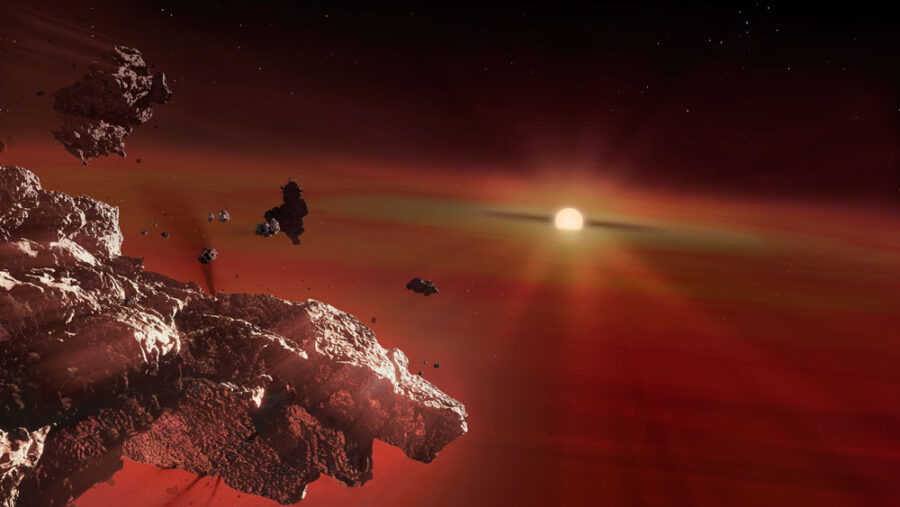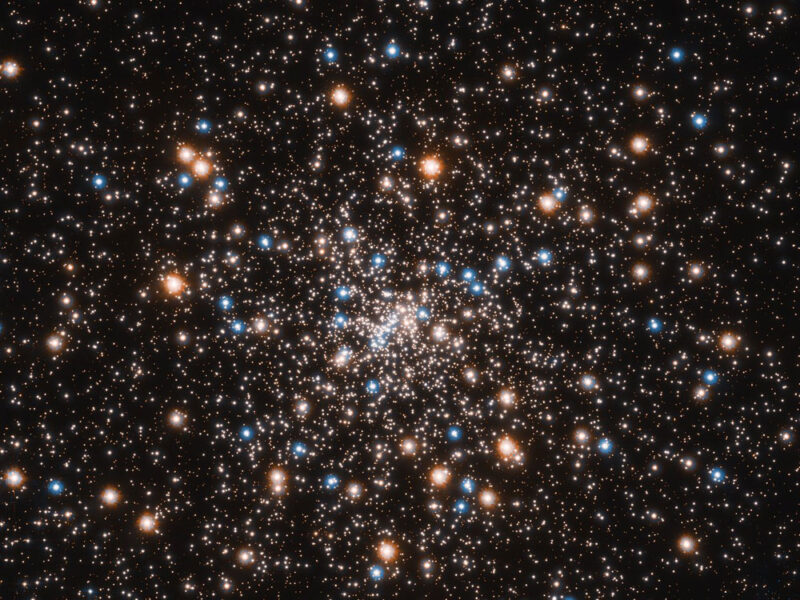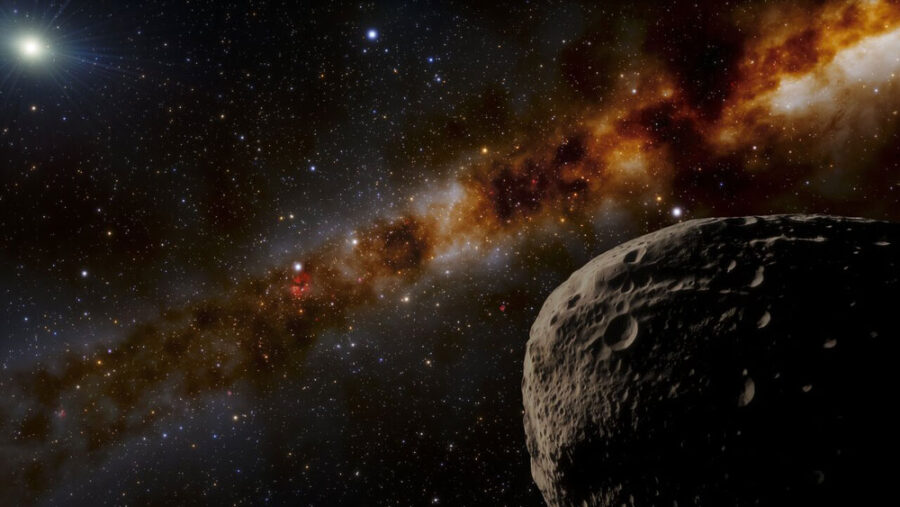This week in astronomy news, astronomers found planet-eating white dwarfs, a cluster of black holes, and a “farfarout” object that’s now the most distant known in the solar system.
Planet-eating White Dwarfs

University of Warwick / Mark Garlick
White dwarfs are surprisingly dirty. Heavier elements sink due to the strong gravity of these collapsed cores of low-mass stars, "cleaning" their atmospheres of all elements but hydrogen and helium. But heavier elements nevertheless contaminate what should be pristine atmospheres, suggesting that white dwarfs are constantly feeding on debris from gravitationally ravaged systems.
Now, using spectroscopy from the Sloan Digital Sky Survey, Mark Hollands (University of Warwick, UK) and colleagues have shown that white dwarfs aren't picky eaters — even the remains of rocky bodies' crusts are found in white dwarf atmospheres.
The spectroscopy revealed the element lithium in the atmosphere of four ancient (5 to 10 billion years old) white dwarfs. One also has potassium. The abundance of these alkali metals compared to other elements, such as sodium and calcium, show chemical make-ups similar to Earth's crust. However, the amounts are small, suggesting what they're seeing are pieces of torn-off crust rather than a planet consumed whole.
The report was published February 11th in Nature Astronomy, and details can also be found in the University of Warwick's press release.
Black Holes Cluster Among Stars

NASA / ESA / T. Brown and S. Casertano (STScI); acknowledgement: NASA / ESA / J. Anderson (STScI)
The globular cluster named NGC 6397 (above) is only about 70 light-years across, yet it packs in thousands of stars. It's a prime location for an intermediate-mass black hole (IMBH), one that has at least hundreds and maybe hundreds of thousands of times the Sun's mass but is still far less weighty than the supermassive black holes at the cores of galaxies. Gravitational-wave detections of surprisingly hefty (but largely still stellar-mass) black holes have lent credence to the existence of IMBHs.
Eduardo Vitral and Gary Mamon (both at the Institute of Astrophysics of Paris) sought to detect an IMBH hiding in the cluster's core by analyzing the motions of NGC 6397's stars using data from the Hubble Space Telescope and the Gaia satellite. Both space observatories provide the detailed measurements over years to help astronomers measure the stars' proper motions across the sky.
“We found very strong evidence for invisible mass in the dense central regions of the cluster, but we were surprised to find that this extra mass is not point-like but extended to a few percent of the size of the cluster,” Vitral explains. While some of this "dark mass" might include white dwarfs and neutron stars, the astronomers calculate that most of it is stellar-mass black holes.
Read more about the discovery in the NASA/ESA press release and in the February issue of Astronomy & Astrophysics.
"Farfarout" Is New Most Distant Solar System Object

NSF NOIRLab
Astronomers have found the most distant object in the solar system, a 400-kilometer rock. The team — Chad Trujillo (Northern Arizona University), Scott Sheppard (Carnegie Institution for Science), and David Tholen (University of Hawai‘i) — actually found the object in January 2018 using observations from the Subaru Telescope. But they needed additional observations from the Gemini North telescope in Hawai‘i and the Magellan telescopes in Chile to confirm its orbit and thus its distance.
The same astronomers had dubbed the previous record-holder, which they also discovered, “Farout.” So naturally, they bestowed this one with the moniker “Farfarout.” More officially, it's provisionally designated 2018 AG37 by the Minor Planet Center. And it really is far, far out, currently at 132 astronomical units from the Sun, nearly four times farther away than Pluto. (Farout, now known as 2018 VG18, is 124 a.u. from the Sun.) Its orbit is elongated, though, so while it travels as far out as 175 a.u., it also comes in as close as 27 a.u., taking it inside Neptune's orbit.
“Farfarout was likely thrown into the outer solar system by getting too close to Neptune in the distant past,” Trujillo says. “Farfarout will likely interact with Neptune again in the future since their orbits still intersect.”
Read more about the discovery in the press releases from the NSF's NOIRLab and the National Astronomical Observatory of Japan's Subaru Telescope (Japanese).
 9
9









Comments
Robert-McCabe
February 15, 2021 at 8:16 am
So Farout crosses Neptune's orbit. Farfarout crosses Neptune's orbit. Pluto crosses Neptune's orbit. It sounds to me like Neptune hasn't cleared out it's orbit. So based upon the definition of a planet as issued by the IAU, Neptune is not a planet.
Things that make you go hmmm...
You must be logged in to post a comment.
Andrew James
February 15, 2021 at 6:00 pm
No. Again. Neptune is a planet. Farout's orbit might intersect Neptune's orbit but its orbit is independent of Neptune'. e.g. Mean distances and eccentricities are vastly different. It is NOT a shared orbit.
Moreover if two different sized bodies were in the same orbit, the larger more massive body is deemed the planet, the smaller body is either a dwarf planet or an asteroid. (If they collide the larger body, the planet would survive.) They don't become two dwarf planets or preclude the plant being the planet. etc.! [If Neptune were the same/similar size as Farout, you could have a valid argument.] This is obviously why Neptune is a planet and Pluto is a dwarf planet.
The IAU definition make perfect sense.
Using inaccurate and incorrect arguments to raise doubt just to promote Pluto back to planet status will not change things. (Also using emotionalism won't change things either.)
Note: I understand why Americans want to be proud of Tombaugh 1930 discovery. The IAU definition is appreciative of that, however it has judged its decision on scientific grounds.
You must be logged in to post a comment.
Robert-McCabe
February 16, 2021 at 9:55 am
I understand. I was being sarcastic. 😉
You must be logged in to post a comment.
Andrew James
February 16, 2021 at 3:12 pm
Things that make you go hmmm...
You must be logged in to post a comment.
richard szweda
February 26, 2021 at 11:21 am
So is there something in Pluto's orbit, which, if it collided with Pluto would destroy Pluto ?
You must be logged in to post a comment.
Andrew James
February 27, 2021 at 5:51 pm
Neptune.
You must be logged in to post a comment.
Andrew James
February 15, 2021 at 6:33 pm
"Clearing an orbit" means either merging planetary bodies or ejecting them into different orbits. This good 2006 Soter "What is a planet.' article might be quite helpful here. https://arxiv.org/abs/astro-ph/0608359 [See Its Fig.1 !]
You must be logged in to post a comment.
Robert-McCabe
February 16, 2021 at 9:56 am
I understand. I was being sarcastic. 😉
You must be logged in to post a comment.
Andrew James
February 16, 2021 at 3:13 pm
Things that make you go hmmm...
You must be logged in to post a comment.
You must be logged in to post a comment.